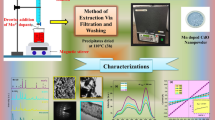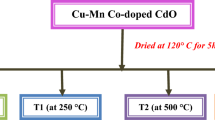Abstract
Europium oxychloride nanopowders codoped with copper/nickel ions were synthesized by solvothermal route followed by a subsequent heat treatment. The present study focuses on determination the conditions required to create stable ferromagnetic (RT-FM) properties in EuOCl crystalline powder. For that purpose, nickel (Ni2+) ions were used as dopant. It was found that such doping could not create FM properties in EuOCl unless followed by hydrogenation. The presence of transition metal (TM) Cu2+ as impurity dopant ions assists to dissociate H2 molecules into H atoms. Moreover, dopant Cu2+ ions donate polarons (electrons) that develop the electronic medium (EMI) of the spin-spin (S.S) long-range interaction in the EuOCl crystalline lattice. Systematic structural, optical, and magnetic properties of pure and Cu/Ni-codoped EuOCl samples were investigated. Their variations with post-annealing treatment in different conditions (temperature and atmosphere) were also studied. The optical properties were studied by diffuse reflection spectroscopy (DRS) method. The magnetic measurements reveal that hydrogenated Cu/Ni-codoped EuOCl nanopowders have RT-FM properties with saturation magnetisation ~ 1.7 emu/g. The physical explanations and discussions were given in the framework of bound magnetic polarons (BMP) theory. Thus, EuOCl nanocrystalline powder could be used as a potential candidate for optical applications with tailored magnetic properties.






Similar content being viewed by others
References
Golovkova, S.I., Gurvich, A.M., Savikhina, T.I., Starick, D., Birman, T.A., Herzog, G., Katomina, R.V., Kra, G.: Luminescence properties of lanthanum oxyhalides activated with terbium. J. Appl. Spectrosc. 35, 1208–1212 (1981)
Marsal, A., Rossinyol, E., Bimbela, F., Tellez, C., Coronas, J., Cornet, A.: Characterisation of LaOCl sensing materials using CO2-TPD, XRD TEM and XPS. Sensors Actuators BChem. 109, 38–43 (2005)
Maslen, E., Streltsov, V., Streltsova, N.: Electron density and optical anisotropy in rhombohedral carbonates. III. Synchrotron X-ray studies of CaCO3, MgCO3 and MnCO3. Acta Crystallogr. 51, 929–939 (1996)
Kong, Q., Wang, J., Dong, X., Wensheng, Y., Liu, G.: Synthesis and luminescence properties of Yb3+- Er3+ co-doped LaOCl nanostructures. J. Mater. Sci. 49, 2919–2931 (2014)
Kim, D., Park, S., Kim, S., Kang, S.-G., Park, J.-C.: Blueemitting Eu2+-activated LaOX (X=Cl, Br, and I) materials crystal field effect. Inorg. Chem. 53, 11966–11973 (2014)
Holsa, J., Lahtinen, M., Lastusaari, M., Valkonen, J., Viljanen, J.: Stability of rare-earth oxychloride phases: bond valence study. J. Solid State Chem. 165, 48–55 (2002)
Holsa, J., Lamminmaki, R.-J., Lastusaari, M., Porcher, P., Saez-Puche, R.: Simulation of the paramagnetic susceptibility in rare earth oxychlorides. J. Alloys Compd. 303–304, 498–504 (2000)
Aitasalo, T., Hölsä, J., Lastusaari, M., Legendziewicz, J., Lehto, L., Lindén, J., Marysko, M.: Structural, magnetic and spectroscopic investigations of europium oxychloride. EuOCl. J. Alloys Compds. 380, 296–302 (2004)
Matas, S., Mihalik, M., Klemke, B., Sokolowski, A.: Low temperature properties of selected Kramers rare earth oxychlorides, EPJ Web of Conferences 40, 11005/1–4 (2013). https://doi.org/10.1051/epjconf/20134011005
Kittel, C.: Introduction to solid state physics, 7th edn. Wiley, New York (1996)
Kaminski, A., Sarma, S.D.: Polaron percolation in diluted magnetic semiconductors. Phys. Rev. Lett. 88, 247202 (2002)
Wolff, P.A., Bhatt, R.N., Durst, A.C.J.: Polaron-polaron interactions in diluted magnetic semiconductors. J. Appl. Phys. 79, 5196–5198 (1996)
Lewis, E.A., Le, D., Murphy, C.J., Jewell, A.D., Mattera, M.F.G., Liriano, M.L., Rahman, T.S., Sykes, E., Charles, H.: Dissociative hydrogen adsorption on close-packed cobalt nanoparticle surfaces. J. Phys. Chem. C. 116, 25868–25873 (2012)
Pozzo, M., Alfe, D.: Hydrogen dissociation and diffusion on transition metal (= Ti, Zr, V, Fe, Ru, Co, Rh, Ni, Pd, Cu, Ag)-doped Mg (0001) surfaces. Int. J. Hydrog. Energy. 34, 1922–1930 (2009)
Schlapbach, L.: Magnetic properties of LaNi5 and their variation with hydrogen absorption and desorption. J. Phys. F: Metal Phys.. 10, 2477–2290 (1980)
Shannon, R.D.: Revised effective ionic radii and systematic studies of interatomic distances in halides and chalcogenides. Acta Cryst. A. 32, 751–767 (1976)
McCusker, L.B., Von Dreele, R.B., Cox, D.E., Loueer, D., Scardi, P.: Rietveld refinement guidelines. J. Appl. Crystallogr. 32, 36–50 (1999)
Sun, W., Jia, Y., Ma, T., Li, D., Li, H., Jiang, L., Zhang, S., Fu, J., Pang, R., Li, C.: Synthesis and photoluminescence properties of a red-emitting phosphor Sr9Mg1.5(PO4)7:Eu3+. ChemistrySelect. 3, 462–468 (2016)
dos S. Rezende, M.V., Amaral, J.B., Valerio, M.E.G., Jackson, R.A.: Optical properties of Pr and Eu-doped SrAl12O19: a theoretical study. Opt. Mater. 48, 105–109 (2015)
Chiu, Z.-W., Hsiao, Y.-J., Fang, T.-H., Ji, L.-W.: Photoluminescence and optoelectronics characteristics of Eu-doped InBO3 nanocrystals. Int. J. Electrochem. Sci. 10, 2391–2399 (2015)
Morales, A.E., Mora, E.S., Pal, U.: Use of diffuse reflectance spectroscopy for optical characterization of un-supported nanostructures. Rev. Mex. Fis. S. 53, 18–22 (2007)
Crangle, J., Goodman, G.M.: The magnetization of pure iron and nickel. Proc. R. Soc. Lond. A. 321, 477–491 (1971)
Author information
Authors and Affiliations
Corresponding author
Rights and permissions
About this article
Cite this article
Dakhel, A.A. Characterization of europium oxychloride nanopowders codoped with Cu/Ni ions synthesized by solvothermal route: significant effect of post-annealing in hydrogen. J Aust Ceram Soc 55, 77–84 (2019). https://doi.org/10.1007/s41779-018-0213-4
Received:
Revised:
Accepted:
Published:
Issue Date:
DOI: https://doi.org/10.1007/s41779-018-0213-4




